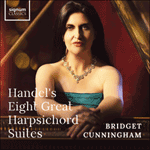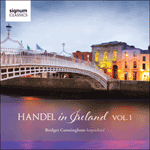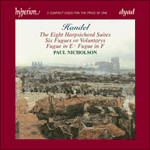
Welcome to Hyperion Records, a British classical label devoted to presenting high-quality recordings of music of all styles and from all periods from the twelfth century to the twenty-first.
Hyperion offers both CDs, and downloads in a number of formats. The site is also available in several languages.
Please use the dropdown buttons to set your preferred options, or use the checkbox to accept the defaults.




After this highly theatrical overture, an Andante and Allegro (really a French allemande and Italian corrente) are discreet, consistently in two parts, one for each hand, with canonic imitations. The sarabande, more harmonic in texture, is heart-easingly lyrical, flowering into additional ornamentation in the repeats. The conventionally Italianate gigue is unpretentious, but Handel adds as finale a massive passacaille: not a series of melodic extensions over an unvarying linear ground, as in Dido’s ‘Lament’, but a set of variations over a chord sequence, beginning in diatonic homophony but increasingly chromaticized into diminished sevenths (the stock operatic ‘chord of horror’, since it consists of two interlinked and rootless tritones). Significantly, this piece is not in the triple rhythm typical of processional passacaglias (and of chaconnes and sarabandes) but is rather in a common time relating back to the fugato section of the overture. It marches remorselessly, generating increasingly virtuosic figuration. There is nothing like this in Bach, and its effect is remarkably similar to that of Handel’s monumentally public choruses in his oratorios. If this Handelian passacaille is ceremonial, it is a procession no longer of court dignitaries, but of affluent British burghers.
from notes by Wilfrid Mellers © 1995
Après cette ouverture très théâtrale, une Andante et un Allégro (en fait, plus une Allemande française et une «Corrente» italienne) sont en comparaison discrets, les deux voix étant partagées entre chaque main, avec des imitations en canon. La Sarabande, de texture plus harmonique, soulage le cœur avec son lyrisme, et conduit à des embellissements additionnels lors des reprises. La Gigue italianisée, conventionnelle, n’est pas prétentieuse, mais Hændel la termine avec une immense Passacaille: non pas par une série d’extensions mélodiques au-dessus d’une base linéaire constante, comme dans le cas du «Lament» de Dido, mais par une série de variations au-dessus d’accords, qui commence en homophonie diatonique, mais qui devient de plus en plus chromatique dans son évolution vers les septièmes diminuées (appelées «accords de l’horreur» à l’opéra, parce qu’elles consistent de deux tritons entrelacés sans note fondamentale). De façon significative, le rythme de cette œuvre n’est pas à trois temps, comme il l’est typiquement dans les Passacaglias processionnelles (ainsi que les Chaconnes et Sarabandes), mais à quatre, rappelant la section fugato de l’ouverture. Il avance inexorablement, engendrant une figuration de plus en plus virtuose. La musique de Bach n’utilise pas ce genre d’effet, et ce rythme est remarquablement similaire à celui des chœurs publics des oratorios d’Hændel. Si cette Passacaille à la manière d’Hændel est cérémonieuse, c’est une procession non plus destinée aux dignitaires de la cour, mais aux riches bourgeois britanniques.
extrait des notes rédigées par Wilfrid Mellers © 1995
Français: Isabelle Dubois
Nach dieser hochtheatralischen Ouvertüre folgen ein dezentes Andante und Allegro (eigentlich eine französische Allemande und eine italienische „Corrente“). Diese sind durchgehend zweistimmig, und jede Stimme wird von einer Hand mit kanonischen Imitationen gespielt. Die in ihrer Struktur stärker harmonische Sarabande wirkt demgegenüber entspannend lyrisch und entfaltet sich in ihren Wiederholungen mittels zusätzlicher Verzierungen. Die Gigue im konventionell ialienischen Stil ist schlicht, aber Händel fügt als Schlußstück eine gewaltige Passacaglia hinzu: diese ist im Gegensatz zu Didos „Klagelied“ keine Reihe von melodischen Erweiterungen über einem unveränderten linearen Grundbaß, sondern eine Kette von Variationen über einer Akkordfolge, die in diatonischer Homophonie beginnt, aber zunehmend zu verminderten Septimen chromatisiert wird (dieser Akkord wird, da er aus zwei miteinander verflochtenen, schwebenden Dreiklängen besteht, in der Oper gewöhnlich als „Schreckensakkord“ gebraucht). Bezeichnenderweise steht dieses Stück nicht in dem für derartige gemessen voranschreitende Passacaglien (und auch für Chaconnen und Sarabanden) typischen Tripeltakt, sondern in einem auf den Fugato-Abschnitt der Ouvertüre zurückweisenden Vierertakt. Es schreitet unbarmherzig voran und erzeugt damit eine zunehmend virtuoses Spiel erfordernde Figurierung. In den Werken Bachs gibt es nicht Derartiges. In seiner Wirkung ähnelt es erstaunlich den gewaltig öffentlichen Chorgesängen, wie wir sie in den Oratorien Händels finden. Diese Händelsche Passacaglia mag zwar ein zeremonielles Gepräge tragen – doch ist dies keine Prozession höfischer Würdenträger mehr, sondern wohlhabender britischer Bürger.
aus dem Begleittext von Wilfrid Mellers © 1995
Deutsch: Angelika Malbert
 Handel: Eight Great Harpsichord Suites Handel: Eight Great Harpsichord SuitesPublished under Royal Privilege in November 1720, Handel's 'Suites de Pièces pour le Clavecin' rapidly gained in popularity across Europe. Better known these days as the 'Eight Great Harpischord Suites', they are here performed on an instrument si ...» More |
 Handel: Handel in Ireland, Vol. 1 Handel: Handel in Ireland, Vol. 1Bridget Cunningham takes her harpsichord to the Dublin of 1741, following in the footsteps of Handel as he sought to revive his fortunes away from London.» More |
 Handel: Harpsichord Suites Handel: Harpsichord Suites‘Superbly recorded. Highly recommended and unlikely to be surpassed in the near future’ (The Penguin Guide to Compact Discs) ‘The commanding nature of these performances, captured in sound of tremendous presence, cannot be denied. Nicholson captures a Handelian dignity and g ...» More |

